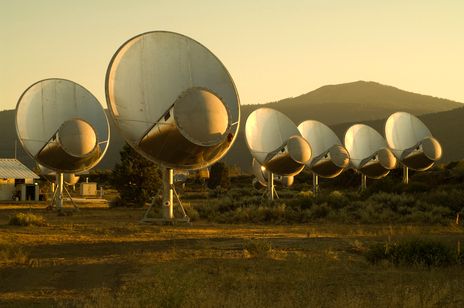 23 July 2012 - In 1960, astronomer
Frank Drake pointed a single radio dish at two nearby stars to hunt for signals from extraterrestrial civilizations. Since then, the search has gotten considerably more high-tech. Among those leading the charge is IEEE Member Gerry Harp, who in May took over as director of research at the
SETI Institute, a position most recently held by famed signal hunter Jill Tarter. IEEE Spectrum Associate Editor Rachel Courtland talked to Harp about the track record of SETI (Search for Extraterrestrial Intelligence) so far and what can be done to improve the search.
23 July 2012 - In 1960, astronomer
Frank Drake pointed a single radio dish at two nearby stars to hunt for signals from extraterrestrial civilizations. Since then, the search has gotten considerably more high-tech. Among those leading the charge is IEEE Member Gerry Harp, who in May took over as director of research at the
SETI Institute, a position most recently held by famed signal hunter Jill Tarter. IEEE Spectrum Associate Editor Rachel Courtland talked to Harp about the track record of SETI (Search for Extraterrestrial Intelligence) so far and what can be done to improve the search.
IEEE Spectrum: The Allen Telescope Array is the only telescope designed specifically to search for signals made by an extraterrestrial intelligence. How does it work?
Gerry Harp:
 The
Allen Telescope Array is not a single-dish telescope. It actually has 42 dishes that each make a measurement of the electric field arriving from space. We take signals from all 42 dishes and add them together with the appropriate coefficients to make an instantaneous snapshot of a very large field of view on the sky.
The
Allen Telescope Array is not a single-dish telescope. It actually has 42 dishes that each make a measurement of the electric field arriving from space. We take signals from all 42 dishes and add them together with the appropriate coefficients to make an instantaneous snapshot of a very large field of view on the sky.
IEEE Spectrum: What exactly are you looking for?
Gerry Harp: The typical signal [we're searching for] is a very, very narrow band signal-we're talking about 1 hertz wide. There's all sorts of reasons why that seems like a good choice, not the least of which is that there's no natural signal that is as narrow as 1 Hz. So if we find such a signal arriving from outer space, it's either E.T. or it's a very interesting astrophysical artifact.
It's always been, from the very start, a guessing game. At the very beginning, Frank Drake made the guess that they would be sending us a very narrow band signal. That was a good guess, and it turns out that subsequent science supported that guess. But more recent developments in technology have called that guess into question, and now we have to ask, "Well, what other ways might they be sending us signals, and how shall we look for them?" We have to develop algorithms to find that stuff, and it's a very challenging problem.
... IEEE Spectrum: Why was it a good guess to presume that an alien civilization would send a narrowband signal?
Gerry Harp: Well, it has to do with what happens to signals as they propagate through the space between stars-we call that the interstellar medium. That interstellar medium is gas that's residual after making the stars in the galaxies. Some of that gas is ionized, so you have free electrons in there. Light interacts with [those] electrons, and its speed changes. High frequencies are less affected, and so they travel faster and arrive sooner than the low frequencies. This is called dispersion. If you have a very, very narrow signal, there's really only one frequency involved, so it really doesn't matter if it gets delayed. When it arrives at the source, it's still intact. It's just a single tone.
But for the last several years, we've been developing ideas to use the telescope in special ways to expand SETI beyond what it has ordinarily been for the last 50 years. E.T. may not send a very narrow signal. The reason is [that] human communication has been going in the direction of wider and wider bandwidth.
A very narrow signal that's only 1 Hz wide carries very small quantities of information. A 3000-Hz signal can carry info up to 1500 bits per second. Many of us think that if E.T. is going to go through all the trouble of building a beacon for us, they're going to build one that has some information encoded on it.
Read more.
